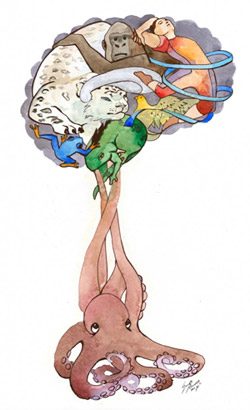The Sixtine Brain

From the bottom of your feet to the top of your head and the vast reaches of your mind, energy has to flow in an integrated fashion to ensure health and spiritual realization.
The triune brain is probably familiar to you, but not the sixtine brain, which I just made up for a good reason. Never mind the resonance with pope Sixtus IV who built the Sistine chapel; on the way to the neurological mysteries of the brain we may as well reach across centuries to admire Michelangelo’s frescos and experience humanity’s cultural potential made possible by the brain’s latest addition, the medial prefrontal cortex. Understanding how we are wired by the nervous system gives us a fresh perspective on who we are and can be very helpful on our mindfulness journey. The triune brain is a term coined by the neuroscientist Paul D. MacLean inthe 1960s to show the evolutionary nature of the brain and how each evolutionary stage is connected with a set of behaviors and a degree of consciousness. The triune brain consists of the oldest reptilian brain complex (brainstem), the more recent paleomammalian complex (limbic system), and the newest neomammalian complex (neocortex) as they emerged sequentially over time. Within this structure we have however 6 levels of neuroprocessing. The picture on this webpage is designed to make my expansion of this original concept to a six-layered model more accessible.
You might wonder why I called the picture below the ‘Brain Forest’. The forest is a place beyond the reach of conventional culture and institutions. It is a place of unobstructed openness, of uncharted chaos and creativity. It teems with life and both harmless and dangerous creatures. Without a map in the forest you get lost, and its dense world gives rise to our wildest imagination, to gods and demons. The forest is the repository of the most extensive biodiversity on the planet. In the forest there are no simple rules to follow, and no presiding authorities orchestrate the forest’s life. The chaos of the forest is the only authority, forcing us to stay present with its infinite potential of spontaneous events and encounters that emerge directly from reality itself, unmediated and undistorted by our human thoughts. Meditation begins and ends with and in the body, our forest we know so little about. Surrendering to the body’s mysteries through somatic attention is at the core of all liberation from suffering. We are then bound to discover a world we cannot comprehend with our thoughts – a healing world of unfathomable potential like the forest, speaking a language we yet have to learn. Let’s see now what this forest is all about.

The Brain Forest – Copyright © 2012 by Dr. Stéphane Treyvaud. All rights reserved.
1. Around the heart, the lungs and the intestines we have a web of nerve cells so complex as to correspond in size to the brain of a cat. Although unclear yet, similar webs of nerve cells may also be found around the muscles. This set of interconnected neurons is said to be connected in a pdp way (parallel-distributed-processing). This awful concept means that this set of interconnected neurons can learn, think and process information. In other words, pdp mechanisms have intelligence to them. Our guts and our heart are capable of processing information in an intelligent way, as the size of this mass of interconnected neurons corresponds approximately to the size of a cat’s brain. The non-rational ways of knowing we have access to, such as intuition, come from the information processing around our bodily organs, maybe from around the muscles also. This forms the most basic and fundamental level of neural processing occurring in the body, called the sensorimotor level. Intuition is thus deeply physical. In the picture this is symbolized by the octopus.
2. Next up is the over 300 million years old brainstem. It is the only area of the brain that is fully wired up and ready for action before birth in full-term babies. It is a reptilian structure and is responsible for two main functions. The first is the basic regulation of physiology by determining states of arousal both downward in the body (heart rate, vessel constriction, respiration, temperature) and upward in the brain (alertness or sleepiness, wake/sleep cycle). The second function are the basic survival reflexes, such as the fight-flight-freeze responses responsible for our survival in times of danger. In the picture this is symbolized by the frog and the lizard.
3. As we continue to move up the evolutionary ladder, we encounter the limbic system or the old mammalian brain. It is also called the social brain; working with the brainstem its five structures (amygdala, hippocampus, hypothalamus, anterior cingulate and orbito-frontal cortex) are dedicated to our motivational, emotional, and relational life, as well as the processes of memory. Attachment research has shown that the neurons of this region are genetically primed to form connections through the relational experiences we have with those closest to us. 200 million years old, it is the first brain structure that characterizes the mammalian species, symbolized in the picture with the bird and the tiger.
4. Next is the neo-cortex (outer layer), generally useful to create more abstract presentations (= re-presentations) of the world to our inner awareness. As the new mammalian brain it creates more intricate firing patterns that represent the three-dimensional world beyond the bodily functions and survival reactions mediated by the lower subcortical regions (sensorimotor, brainstem and limbic system). From both a developmental and an evolutionary perspective, the subcortical regions of the brain develop from bottom up, and the cortical regions from back to front. The more forward one moves in the cortical brain, the more complex and abstract the representations. The posterior cortical areas create representations of things, such as a hand, a tree. The frontal cortical areas create representations of concepts such as freedom, justice, awakening, future, concept of death, and are especially devoted to reasoning and relationships. At the level of animals, the frontal cortical areas are more rudimentary as most of their cortex consists of the more posterior parts. This is symbolized in the picture as a gorilla.
5. In its most evolved form, the cortex grew forward and developed the medial prefrontal cortex (MPC), a cortical structure extensively only found in humans (some animals, such as whales, dolphins, elephants and chimps have beginnings of it). This is depicted by the person in the picture. Its firing patterns are capable of representing their own representations, which means that it allows us to think about thinking, be aware of being aware. This opens up the unique human capacity to learn, create and destroy, to develop a whole virtual world thought, with which we can manipulate our environment and create a human culture and civilization. The MPC creates what we feel is the essence of being human, the sense of having a soul. It is massively connected in two ways. It has a unique location, which connects it directly to every other part of the brain and the body: The cortex, limbic area, brainstem, and the body. The MPC includes and is also closely connected with the resonance circuitry (mirror neurons), also called the social brain discussed below.
6. The social brain with its mirror neurons connects and attunes us with the minds of others and our own minds. It connects us with other people’s nervous systems by making maps of other people’s minds. This is depicted by the dancer, implying cultural communication among human beings.
Here is the idea:
- In mindfulness meditation we harness a power inherent in the MPC we usually rarely use the power of holding in awareness what we need to hold in awareness without being distracted. We learn to hold our attention there where we intend to hold it, instead of having our attention wander all over the place like a fruit fly. Neurobiological findings have confirmed that this simple act has huge positive impacts on our organism’s ability to move away from chaos and rigidity in our lives towards integration, a notion that describes a stable harmony.
- Knowledge of the sixtine brain also shows us the importance of honing connections with all six parts of who we are. In popular parlance I tell people that listening to their guts (sensorimotor level) only when it is in conflict with their head (cortical level), or listening to their heart (sensorimotor level) when it is in conflict with their guts, or listening to their emotions (limbic level) when it is in conflict with their heads (cortical level) is bound to turn out badly. Depending on how we had to develop reality processing distortions to survive our childhoods, our guts can be very wrong and our heads right, or our heads can be wrong and our hearts right, etc. What is important here is to develop the fine skill of accessing all six levels of neuro-processing, being able to identify all the elements of experience in each of the six levels, and bring them into an integrated state, in which all six levels cooperate like the musicians of a well-lead orchestra.
- There is a bottom-up and top-down flow to neurobiological processing. What happens in the body (sensorimotor) is more fixed, automatic and concrete, while the more you move upwards, the more flexible and abstract the processing of experience becomes. Conversely, the more fixed bodily processes are also the most here-and-now present moment experiences, while cortical thought experiences are the most non-present experiences occurring in times that never exist, the past and the future. Through this bidirectional flow of energy thought can deeply influence the body, and the body is the foundation for all thinking. In other words, the very structure of reason itself comes from the particular characteristics of our embodiment. But there is also an asymmetry: All cortical processing is dependent on the lower levels of processing, ultimately the sensorimotor processing in the body. The same cannot be stated the other way round: Sensorimotor processing unfolds independent of the manner of cortical processing. Whatever you think and do will be dependent on your body, but your body will do what it has to do independently of what you think. We are witnessing an educational crisis in our society, in which the natural right-brain, body- and relationship-oriented developmental phase of childhood gets caged and damaged by a precocious left-brain academic emphasis that cuts us off from the truth of the body that sustains us. This top-down/bottom-up dynamic underscores the importance of emphasizing meditative attention to and connection with the body, called somatic attention.







